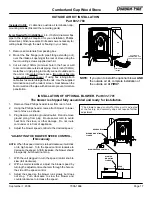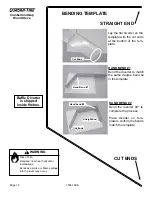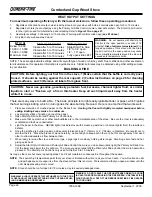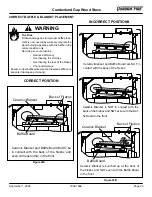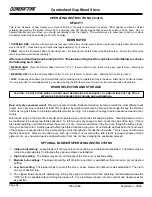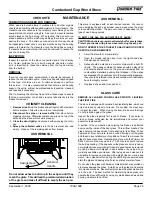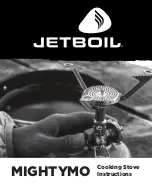
Page 11
Cumberland Gap Wood Stove
R
September 1, 2008
7006-188E
To be sure that your Quadra-Fire stove burns properly, the
chimney draft (static pressure) should be approximately -.04”
water column (W.C.) during a low burn and -.10” W.C. during
a high burn, measured 6” (152mm) above the top of the stove
after one hour of operation at each burn setting.
NOTE
: These
are guidelines only, and may vary somewhat for individual
installations.
This stove was designed for and tested on a 6” (152mm)
chimney, 12 ft.-14 ft. (360-420cm) high, measured from the
base of the stove. The further your stack height or diameter
varies from this configuration, the possibility of performance
problems increases. In addition, exterior conditions such
as roof line, surrounding trees, prevailing winds and nearby
hills can influence stove performance. Your local dealer is
the expert in your geographic area and can usually make
suggestions or discover problems that will easily correct
your flue draft problem, allowing your woodstove and its flue
system to operate correctly and provide safe and economical
heat for your home.
A masonry chimney or a listed factory-built UL103 HT Class
“A” chimney must be the required height above the roof
and any other nearby obstructions. The chimney must be
at least 3 ft. (91cm) higher than the highest point where it
passes through the roof and at least 2 ft. (61cm) higher than
the highest part of the roof or structure that is within 10 ft.
(305cm) of the chimney, measured horizontally.
See 2-10-3
Rule, Figure 11A
.
T
hese are safety requirements and are not meant to
assure proper flue draft.
We recommend using a minimum total system height of 12
ft. (360cm), measured from the flue collar to the top of the
chimney (not including chimney cap).
Availability of combustion air:
A source of air (oxygen) is
necessary in order for combustion to take place. It is impor-
tant to realize that whatever combustion air is consumed
by the fire must be replaced. If you are using room air, the
air is replaced via air leakage that occurs around windows
and under doors, etc. However, in most newly constructed
houses, mobile homes, or even existing homes that are
fitted with tightly sealed doors and windows, the area from
which the combustion air is taken is relatively air tight. In
these cases, an outside air source must be made available
to feed combustion air from outside the home into the stove.
An Outside Air Kit is available for the Cumberland Gap as an
option, Part 831-1780. The kit is a requirement for mobile
home installations.
CHIMNEY HEIGHT REQUIREMENTS / DRAFT
3 ft Min
(91cm)
2 ft Min (61cm)
10 ft Min
(305cm)
2-10-3 RULE
Figure 11A
FLUE SYSTEMS
Figure 11B - Chimney Connector
FLUE
GAS
DIRECTION
CRIMPED
END
TOWARDS
STOVE
There are two separate and different parts to a flue system:
the chimney connector and the chimney itself.
A. Single wall connector or stove pipe.
This must be at
least 24 gauge mild steel or 26 gauge blue steel. The
sections must be attached to the stove and to each other
with the crimped (male) end pointing toward the stove.
See Figure 11B
. All joints, including the connection
at the stove collar, should be secured with three sheet
metal screws. Make sure to follow the minimum clear-
ances to combustibles as set out on
pages 6-8
of this
manual. Where passage through the wall, or partition of
combustible construction is desired, the installation shall
conform to CAN/CSA-B365.
B. Factory-built listed chimney connector (vented)
. A
listed connector (vented) must be used when installing
this unit in a mobile home or residental home. They must
conform to each other to ensure a prope fit and seal.

















